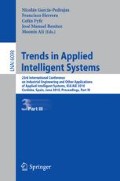Abstract
This paper presents a machine learning model for short-term prediction. The proposed procedure is based on regression techniques and on the use of a special type of probabilistic finite automata. The model is built in two stages. In the first stage, the most significant independent variable is detected, then observations are classified according to the value of this variable and regressions are re-run separately for each Group. The significant independent variables in each group are then discretized. The PFA is built with all this information. In the second stage, the next value of the dependent variable is predicted using an algorithm for short term forecasting which is based on the information stored in the PFA. An empirical application for global solar radiation data is also presented. The predictive performance of the procedure is compared to that of classical dynamic regression and a substantial improvement is achieved with our procedure.
Access this chapter
Tax calculation will be finalised at checkout
Purchases are for personal use only
Preview
Unable to display preview. Download preview PDF.
References
Box, G.E.P., Jenkins, G.M.: Time Series Analysis forecasting and control. Prentice Hall, USA (1976)
Tong, H.: Non-linear time series. A dynamical system approach. Oxford University Press, Oxford (1990)
TeRäsvirta, T., Lin, F., Granger, C.W.J.: Power of the neural network linearity test. Journal of time series analysis 14 (1993)
Nadas, A.: Estimation of probabilities in the language model of the IBM speech recognition system. IEEE Trans. on ASSP 32(4) (1984)
Rabiner, L.R.: A tutorial on Hidden Markov Models and Selected Applications in Speech Recognition. In: Proceedings of the Seventh Annual Workshop on Computational Learning Theory (1994)
Ron, D., Singer, Y., Tishby, N.: On the Learnability and Usage of Acyclic Probabilistic Finite Automata. Journal of Computer and System Sciences 56 (1998)
Zhang, G., Peter, Q.I., QI, M.: Neural network forecasting for seasonal and trend time series. European Journal of Operational Research 160 (2005)
Vidal, E., Thollard, F., Higuera, C., Casacuberta, F., Carrasco, R.C.: Probabilistic Finite-State Machines-Part I. IEEE Transactions on Pattern Analysis and Machine Intelligence 27(7), 1013–1025 (2005)
Palmer, N., Goldberg, P.W.: PAC-learnability of probabilistic deterministic finite state automata in terms of variation distance. Theoretical Computer Science 387(1), 18–31 (2007)
Ingsrisawang, L., Ingsriswang, S., Somchit, S., Aungsuratana, P., Khantiyanan, W.: Machine Learning Techniques for Short-Term Rain Forecasting System in the Northeastern Part of Thailand. Proceedings of World Academy of Science, Engineering and Technology 31 (2008)
Wang, C.H., Hsu, L.C.: Constructing and applying an improved fuzzy time series model: Taking the tourism industry for example. Expert Systems with Applications 34 (2008)
Mora-López, L., Mora, J., Sidrach-de-Cardona, M., Morales-Bueno, R.: Modelling time series of climatic parameters with probabilistic finite automata. Environmental modelling and software 20(6) (2004)
Ron, D., Singer, Y., Tishby, N.: Learning Probabilistic Automata with Variable Memory Length. In: Proceedings of the Seventh Annual ACM Conference on Computational Learning Theory (1994)
Dougherty, J., Kohavi, R., Sahami, M.: Supervised and Unsupervised Discretization of Continuous Features. In: Proceedings of the Twelf International Conference on Machine Learning, Los Altos, CA, pp. 194–202. Morgan Kaufmann, San Francisco (1995)
Lui, H., Hussain, F., Lim Tan, C., Dash, M.: Discretization: An enabling Technique. Data Mining and Knowledge Discovery 6, 393–423 (2002)
Perner, P., Trautzsch, S.: Multi-interval Discretization Methods for Decision Tree Learning. In: SSPR/SPR, pp. 475–482 (1998)
Author information
Authors and Affiliations
Editor information
Editors and Affiliations
Rights and permissions
Copyright information
© 2010 Springer-Verlag Berlin Heidelberg
About this paper
Cite this paper
Mora-Lopez, L., Mora, J., Piliougine, M., Sidrach-de-Cardona, M. (2010). An Intelligent Memory Model for Short-Term Prediction: An Application to Global Solar Radiation Data. In: García-Pedrajas, N., Herrera, F., Fyfe, C., Benítez, J.M., Ali, M. (eds) Trends in Applied Intelligent Systems. IEA/AIE 2010. Lecture Notes in Computer Science(), vol 6098. Springer, Berlin, Heidelberg. https://doi.org/10.1007/978-3-642-13033-5_61
Download citation
DOI: https://doi.org/10.1007/978-3-642-13033-5_61
Publisher Name: Springer, Berlin, Heidelberg
Print ISBN: 978-3-642-13032-8
Online ISBN: 978-3-642-13033-5
eBook Packages: Computer ScienceComputer Science (R0)

